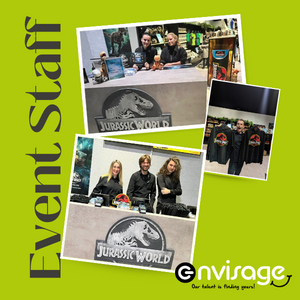Envisage working with the British Beekeepers Association The British Beekeepers Association is a non-profit organisation…
Beginner’s Guide to International Exhibitions and Trade Shows
Expanding your customer base can mean spreading your physical wings and taking the leap by showcasing your brand, products, and services on the international exhibition circuit. It can feel a lot more daunting when you have to load your luggage onto a plane and spend four days in foreign climates, pushing your business forward rather than traveling across the UK.
You still want optimal returns on international exhibitions but just how do you go about doing this when you are in such unfamiliar territory?
#1 Familiarise yourself with customs and cultures
A common mistake many clients make is the assumption that because their product, branding, and slogans etc. were well received on the UK exhibition circuit, that it will automatically translate for European and global markets.
But what is a joke here, is offensive in the Far East. Or what is acceptable and appropriate practice in another country may not be very well received here.
So before you pack up your exhibition bags, familiarise yourself with the customs and culture of the country you are visiting.
For example, take a look at;
- Language – business partners in some countries expect straight talking but in other countries, a less direct, more social approach is needed.
- Greetings and introductions – research how you should greet someone, sticking with the formal until you are sure that you can use someone’s first name.
- Gestures – body language is just as important. For example, we see the thumbs up sign as an indication someone is OK or they have understood what we are saying. But in Greece and Sardinia, this is the equivalent of ‘the middle finger’…
- Touch – in some culture, like in Middle Eastern countries, touching another person is a faux pas that is frowned upon.
- Eye contact – it can be a sign of confidence but in Middle Eastern countries, same-sex eye contact tends to last longer than we are comfortable with. And sometimes, making eye contact is not welcomed at all.
- Offers, deals and packages – is what you are offering of value in the country where you are working? Again, it may be that some international business partners expect a long ‘courtship’ process rather than a quick deal with 10% off.
There are many websites that list the do’s and don’ts whilst visiting countries across the globe. For example, exhibition staff chewing gum at a conference in Singapore won’t be very welcomed by delegates.
#2 Revise your objectives
In effect, you are performing the same steps for an international exhibition as you would for a domestic one. But clearly, revising key indicators such as the number of leads etc. will mean a revision of objectives will be necessary.
This is key when pricing your products or service. You will need to research the tax arrangements for the country and how this impacts on your bottom line, as well as the deals you will offer.
You will also need to be familiar with the local economy too, its outlook and how the industry you are in is being affected by challenges and opportunities within the country you are visiting.
#3 Hire exhibition staff with the necessary language skills
When TV or film production companies film abroad, they use a local ‘fixer’, someone who has knowledge of the local customs, cultures and language. Making sure the right formality of language in a business setting is important.
For example, “hello” in China is seen as a little too informal and not as respectful as asking how someone is as a conversation opener.
Thus, hiring staff who not only have experience of the international exhibition market but also the language skills is an important move.
#4 Stay on message
You have spent time and money creating a brand, its persona and voice, so why make a change? We live in an ever-shrinking world as so the attendees of an exhibition in Singapore could cross paths with a business associate thousands of miles away – and if your message isn’t the same, it could spell trouble for your reputation.
Consistency with how you staff exhibitions, at home and abroad is key to maintaining cohesion around your brand.
#5 Get to grips with logistics
Shipping your booth well before the event is key to making sure that when your team arrives on site, they have everything they need to build the stand and make the exhibition a success.
But you need to get to grips with logistics;
- Consider the customs code of the country if you are shipping in goods, especially items that are perishable or food based
- Check out all the freight options – air freight is quicker but more expensive than shipping
- Consider renting your stand from an agency or company in the host country
- Map out a timeline of what is being sent and when including WHO is responsible for pulling it all together.
#6 Familiarise yourself with the exhibition rulebook
Just like in the UK, there are codes and regulations that event organisers must follow which means you have to follow them too.
Exhibition deadlines are important to observe as some countries are more strict in how these are applied than others. For example, miss the deadline to include food and drink at an exhibition in Germany and you will find you have ‘missed the boat’.
The good news is, most exhibitions will have a pack with all this information in, as well as other useful bits of info.
#7 Get the basics in order
Just like any other exhibition, you need to optimize your time at the event and that means;
- Having a strategy for international exhibitions, and goals for each one you choose to attend
- Align the exhibitions with your business objectives
- Check that your target audience is likely to attend the exhibition
- Get the right international exhibition team
Are you looking to expand your global reach? We have the internal exhibition teams you need for success, call us 0844 800 0071.



